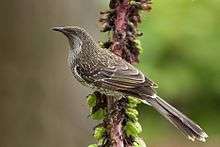Little wattlebird
| Little wattlebird | |
|---|---|
 | |
| Scientific classification | |
| Kingdom: | Animalia |
| Phylum: | Chordata |
| Class: | Aves |
| Order: | Passeriformes |
| Family: | Meliphagidae |
| Genus: | Anthochaera |
| Species: | A. chrysoptera |
| Binomial name | |
| Anthochaera chrysoptera (Latham, 1801) | |
The little wattlebird (Anthochaera chrysoptera), also known as the brush wattlebird, is a honeyeater, a passerine bird in the family Meliphagidae. It is found in coastal and sub-coastal south-eastern Australia.
Taxonomy
The species was originally described by the ornithologist John Latham in 1801 under the binomial name Merops chrysoptera.[2][3] Its specific epithet is derived from the Ancient Greek chryso "golden", and pteron "wing(ed)".[4]
The International Ornithologists' Union recognise three subspecies:[3]
- A. c. chrysoptera (Latham, 1801) – eastern and southeastern Australia
- A. c. halmaturina (Mathews, 1912) – Kangaroo Island (off southern Australia)
- A. c. tasmanica (Mathews, 1912) – Tasmania
The western wattlebird (A. lunulata) was at one time considered as a subspecies.[5]
Description
The little wattlebird is a medium to large honeyeater, but the smallest wattlebird.[6] The appearance is similar to the yellow wattlebird and the red wattlebird.[7] The little wattlebird lacks the wattles which characterise the wattlebirds.
Juveniles are duller with less streaking and have a browner eye.[6]
Distribution and habitat
The little wattlebird is found in banksia/eucalypt woodlands, heathlands, tea-tree scrub, sandplain-heaths, lantana thickets, wild tobacco, parks and gardens.[7]
Behaviour

Call
Calls include a strident cookay-cok, a raucous fetch the gun, a mellow guttural yekkop, yekkop and many squeaky, musical lilting notes. The alarm call is a kwock or shnairt!.[7]
Breeding

September 2002, NSW
Breeding takes place from June to December.[7] The female wattlebird generally constructs the nest,[6] a loose, untidy cup of twigs lined with shredded bark and placed from 1 to 10m high in the fork of a banksia, tea-tree or eucalypt sapling.[7] 1-2 eggs are laid and may be spotted red-brown, purplish red or salmon-pink in colour.[7] The female incubates the eggs alone.[6] Both sexes care for young chicks.[6]
Feeding

Little wattlebirds feed on nectar obtained with a long, brush-tipped tongue, adapted for probing deep into flowers.[6] They also feed on insects, berries and some seeds.[6] Most feeding is done perched but some insects are caught in mid-air. Birds may feed alone or in groups.[6]
References
- ↑ BirdLife International (2012). "Anthochaera chrysoptera". IUCN Red List of Threatened Species. Version 2013.2. International Union for Conservation of Nature. Retrieved 26 November 2013.
- ↑ Latham, John (1801). Supplementum indicis ornithologici sive systematis ornithologiae (in Latin). London: Leigh & Sotheby. p. xxxiii.
- 1 2 Gill, Frank; Donsker, David (eds.). "Honeyeaters". World Bird List Version 5.4. International Ornithologists' Union. Retrieved 26 December 2015.
- ↑ Liddell, Henry George & Robert Scott (1980). A Greek-English Lexicon (Abridged Edition). United Kingdom: Oxford University Press. ISBN 0-19-910207-4.
- ↑ Salomonsen, F. (1967). "Family Maliphagidae, Honeyeaters". In Paynter, R.A. Jnr. Check-list of birds of the world (Volume 12). Cambridge, Mass.: Museum of Comparative Zoology. p. 446.
- 1 2 3 4 5 6 7 8 Birds in Backyards - Little Wattlebird
- 1 2 3 4 5 6 Pizzey, Graham; Knight, Frank (1997). Field Guide to the Birds of Australia. Sydney, Australia: HarperCollinsPublishers. p. 111. ISBN 0-207-18013-X.
| Wikimedia Commons has media related to Anthochaera chrysoptera. |
| Wikispecies has information related to: Anthochaera chrysoptera |
